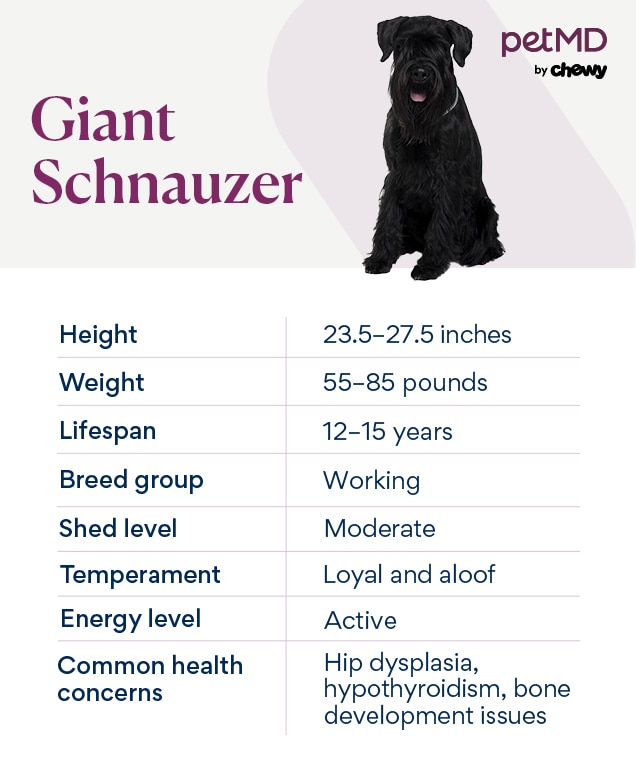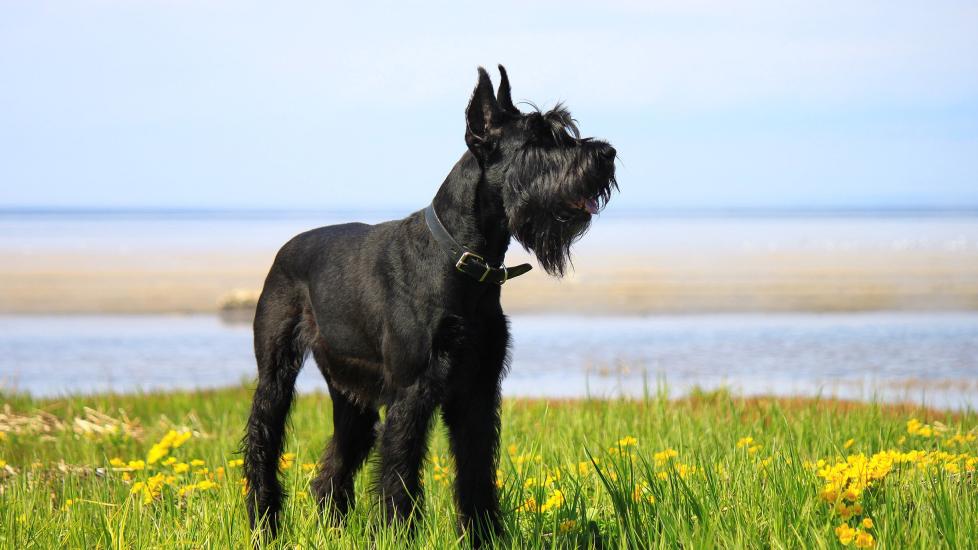Giant Schnauzer
The Giant Schnauzer is the largest of the three Schnauzer breeds (the others being the Standard Schnauzer and the Miniature Schnauzer). These big Schnauzers stand 23.5-28.5 inches at the shoulder and weigh up to 85 pounds—that’s a 65-pound difference from Miniature Schnauzers.
The breed was developed in Germany from breeding Standard Schnauzers with Great Danes, according to the Giant Schnauzer Club of America, to work as farm and home guardians. Today, these brave and loyal dogs have mostly traded farm life to work as police and military dogs.
Caring for a Giant Schnauzer

Giant Schnauzers are intelligent dogs that are eager to please and easily trained. But they are also high-energy dogs that require daily exercise as well as mental stimulation through training sessions and playtime. While they’ve been bred to guard and therefore might be a little suspicious around new people, they are sweet and gentle with their family. Pet parents must socialize their Giant Schnauzer puppy as early as possible to teach them that new people, animals, and experiences aren’t scary.
Along with training, socialization, and regular stimulation, Giant Schnauzers have a wiry double coat that makes regular visits to the groomer and daily brushing a must.
Giant Schnauzer Health Issues
The Giant Schnauzer lifespan is typically 12-15 years, and they are a generally healthy breed. However, they are prone to certain health conditions, and your Giant Schnauzer dog should be seen by a veterinarian at least every 12 months.
Hip Dysplasia
Hip dysplasia is a developmental disease common in many large-breed dogs, including the Giant Schnauzer. As puppies grow, three bones in the pelvis must fuse to form the hip joint around the top of the femur (thigh bone). If those bones don’t fuse properly, it results in a hip joint that is too shallow or is loose. This causes pain and, eventually, arthritis.
X-rays can be used to detect hip dysplasia, and the condition is most commonly managed with medication and joint supplements to reduce pain and slow the progression of arthritis. Surgery may be recommended in severe cases.
Osteochondritis Dissecans (OCD)
OCD in dogs is a developmental disease seen in young, large-breed dogs that affects cartilage and bone development. When bones are growing, they briefly start as cartilage, then change into bone near the growth plates, at the ends of the bones. When a dog has OCD, the cartilage doesn’t change to bone and, instead, separates from the bone. The result is pain and limping.
In Giant Schnauzers, this is most seen in the elbows and shoulders. Typically, you will see signs of limping or pain in Giant Schnauzer puppies 3-9 months old.
This condition is linked to diet, so feeding your Giant Schnauzer puppy a large-breed puppy food that’s not too high in protein and has an appropriate calcium-to-phosphorus ratio is important to prevent OCD. Treatment can involve surgery to remove the abnormal cartilage. Medication to manage their post-surgery discomfort may be prescribed.
Hypothyroidism
Hypothyroidism in dogs is the result of an autoimmune disease that destroys the hormone-producing cells in the thyroid gland. The thyroid hormone is important for metabolism and skin health; signs of hypothyroidism include obesity, low energy, a dull coat, and an increase in skin infections. Dogs with hypothyroidism typically will not show signs until after a substantial amount of the thyroid gland is destroyed.
This condition is treated with lifelong daily medication. With treatment, dogs with hypothyroidism can go on to live a normal, healthy life.
What To Feed a Giant Schnauzer
It’s important to feed your Giant Schnauzer a high-quality, large-breed dog food. Go-to dog food brands include Royal Canin, Hill’s Science Diet, or Purina Pro Plan. Grain-inclusive diets are always recommended to prevent heart disease.
How To Feed a Giant Schnauzer
Giant Schnauzers should be fed a measured amount of food twice daily, ideally at the same times every day. Giant Schnauzers are curious and intelligent dogs that like a challenge, so they enjoy slow feeder bowls and puzzle feeders for their meals.
To help prevent OCD and hip dysplasia, Giant Schnauzer puppies should be on large-breed puppy food until they are at least 1 year old. Puppies should also be fed more often than full-size Schnauzers (three or four times per day) on a consistent feeding schedule.
How Much Should You Feed a Giant Schnauzer?
Your Schnauzer’s dog food bag is the best place to find information on how much to feed them. That said, it’s important that Giant Schnauzers aren’t overfed—this can lead to obesity—so speak with your veterinarian about your dog’s diet.
Keep in mind: Giant Schnauzers are, as their name implies, giant. So they need a lot more food than smaller dog breeds do. Your dog food budget can add up quickly when you bring home a Giant Schnauzer puppy—up to $100 a month or more.
Nutritional Tips for Giant Schnauzers
As a large dog, the Giant Schnauzer is more likely to develop arthritis as they age, especially if they have OCD or hip dysplasia. However, using a high-quality joint supplement containing glucosamine and chondroitin has been proven to slow the development and progression of arthritis. Commonly recommended brands are Cosequin, Dasuquin, and VetriScience Joint Support.
Behavior and Training Tips for Giant Schnauzers
Giant Schnauzer Personality and Temperament
The Giant Schnauzer is a very intelligent and high-energy dog. They are affectionate and playful, but they’re also vigilant and can be wary of strangers initially. Like all dogs, Giant Schnauzers must be indoor dogs because they enjoy being with their people—but they also need a fenced yard to play and exercise daily with their favorite human.
Giant Schnauzer Behavior
As long as Giant Schnauzers get sufficient exercise, socialization, and play, they are generally well-behaved dogs. That said, they are always on alert and will bark to let their family know if anything seems suspicious to them—even if it’s just a neighbor walking down the sidewalk.
Giant Schnauzer Training
Giant Schnauzers are easily trained because they are eager to please and attentive to their family. Like all dogs, they respond well to positive reinforcement methods. Training and socialization need to begin when your Schnauzer is a puppy so they can overcome their wary, territorial tendencies. Full-grown Schnauzers excel at agility, herding, coursing, and obedience.
Fun Activities for Giant Schnauzers
-
Running
-
Hiking
-
Long walks
-
Scent tracking
-
Agility
-
Fetch
Giant Schnauzer Grooming Guide
The Giant Schnauzer has a wiry double coat with characteristic heavy eyebrows and a beard. All this hair requires regular weekly brushing as well as regular professional grooming.
Skin Care
Beyond regular bathing and grooming to maintain the coat, Giant Schnauzers do not have specific skin considerations. Any redness, sores, scabbing, or hair loss should be evaluated by a veterinarian as soon as possible.
Coat Care
Weekly brushing is required to help prevent the Giant Schnauzer’s coat from matting. Every few months, your dog will need to be professionally groomed, where the coat will be stripped out. Shaving or clipping the coat can damage the texture, leading to more matting—and the need for more frequent grooming.
Eye Care
Giant Schnauzers grow heavy eyebrows that a groomer must trim regularly so the brows don’t interfere with eyes or vision. Any redness or cloudiness of the eyes, squinting, holding the eyes closed, or yellow or green discharge from the eyes should be evaluated by a veterinarian as soon as possible.
Ear Care
Giant Schnauzers can develop ear infections. Their ears should be checked weekly for discharge, redness, or odors; any of these changes should be evaluated by a veterinarian. Cleaning your dog’s ears every week or two with a dog-specific ear cleanser can help keep their canals healthy.
Considerations for Pet Parents
Anyone considering bringing home a Giant Schnauzer, whether from a breeder or Giant Schnauzer rescue, will need two things: a house with a yard, and the ability to give their dog at least 40-60 minutes of exercise and play every day. Giant Schnauzers don’t do well in apartments or in homes where people aren’t home much.
Well-trained Giant Schnauzers get along well with kids and other dogs, but they generally do best in homes with older kids, as small kiddos can easily be knocked down by these big Schnauzers during play. Giant Schnauzers need a family who will dedicate themselves to their dog’s training and exercise; the pups also require weekly brushing at home and professional grooming every two to four months.
Giant Schnauzer FAQs
What are the different Schnauzer sizes?
There are three sizes of Schnauzers: Giant, Standard, and Miniature.
- Miniature Schnauzers weigh 11-20 pounds and stand 12-14 inches tall.
- Standard Schnauzers weigh 30-50 pounds and stand up to 20 inches tall.
- Giant Schnauzers weigh 55-85 pounds and stand 23.5-27.5 inches tall.
Both the Giant and Miniature Schnauzers are derived from Standard Schnauzers in Germany.
Is a Giant Schnauzer hypoallergenic?
No dog is completely hypoallergenic. And while the Miniature Schnauzer and Standard Schnauzer breeds can be a good fit for people with dog allergies, Giant Schnauzers are not, thanks to their large size and thick double coat.
How much does a Giant Schnauzer cost?
A Giant Schnauzer from a reputable, experienced breeder can cost $1,200-$3,500. Potential pet parents should also factor in monthly grooming and food costs.
Is a Giant Schnauzer a good family dog?
Giant Schnauzers can be difficult around strangers; require a lot of time, training, and grooming; and are very energetic. They are not recommended for first-time pet parents or families with small children, small dogs, or cats. But with proper training and socialization, Giant Schnauzers do well with other large dogs and children who are at least 10 years old. Well-trained, well-socialized Giant Schnauzers are very affectionate toward their family.
Featured Image: Adobe/Karsa
